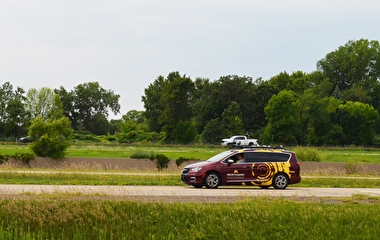pavement markings to meet the needs of CAVs. Photo: 3M
As part of the Automated Vehicle Researcher Symposium, CTS invited a panel of representatives from public agencies and private industry to share their interests, hopes, and concerns related to connected and automated vehicles (CAVs) in Minnesota.
What is your organization’s biggest challenge and greatest hope for CAVs?
“Our challenge is trying to provide answers to our customers and make wise investments when not knowing the future,” said Jay Hietpas, director of the MnDOT CAV-X office. “Our greatest hope is that it will save lives and improve the quality of life for Minnesotans.”
Gina Buccellato, technical director of 3M’s Transportation Safety Division, noted that forming effective partnerships with automotive manufacturers and hiring employees with the right skill sets are two of 3M’s most significant challenges. “Our hope is that this technology will actually meet the promise of improved safety that we’ve been hearing about, and that the corner cases and challenges that we have around things like work zones, intersections, and interactions with other vehicles can be solved,” she said.
“There is a lot of fear and misconceptions at the local level. We need education, for both policymakers and the public,” explained Wayne Sandberg, deputy director of the Washington County Department of Public Works. In addition to improving safety, Sandberg said he hopes CAVs will help with the cost of transportation. “At the end of the day, we’re in a service industry, and our services are provided at a cost that has continued to rise…I hope this technology starts driving the cost down and increasing accessibility.”
“The challenge is preparing our staffing, policies, and infrastructure for whatever is going to be coming,” said Danielle Elkins, a FUSE executive fellow working with the City of Minneapolis. “Our hope is that CAVs increase access, prosperity, safety, and equity for all of our residents. We want people to get where they need to go and access the goods and services they need to live a good life.”
How is industry approaching the transition to CAV-related products and services?
“We’re focused on how to address both user groups: human drivers and CAVs,” Buccellato explained. “An early challenge is elevating the role of infrastructure in enabling these vehicles. For example, we need to be thinking about what a pavement marking needs to do to be useful to the CAV in order to guide it. How do we enable sensors to provide information to the vehicle? We’ve had to reach out to vehicle manufacturers as well as the folks developing the sensors to understand their vision and work alongside them in developing these new materials.”
Where might AV be part of the solution to challenges your agency is facing?
“Our goal is to provide a transportation system that maximizes the health of people, the environment, and the economy,” Hietpas said. “CAVs could help us get people better access to things like jobs and health care. It could also help us with congestion problems, since we can’t build our way out of everything. Ultimately, we hope it will help provide more affordable, accessible transportation options.”
“One of the top things we consistently hear from residents is the need for access to transportation. Transit lines are finite and don’t serve some important locations in our county,” Sandberg said, citing the government complex in Stillwater as an example. “People can’t get to court dates, doctor’s appointments, or even their jobs. Depending on how CAVs are implemented, they could address some of these major transportation equity issues.”
“As a large city, we’re dealing with limited space,” said Elkins. “We need to convince as many people as possible to take fewer single-occupancy vehicle trips because there isn’t room. Our hope is that CAVs are also shared and electric and can address safety, equity, and climate issues as well.”



